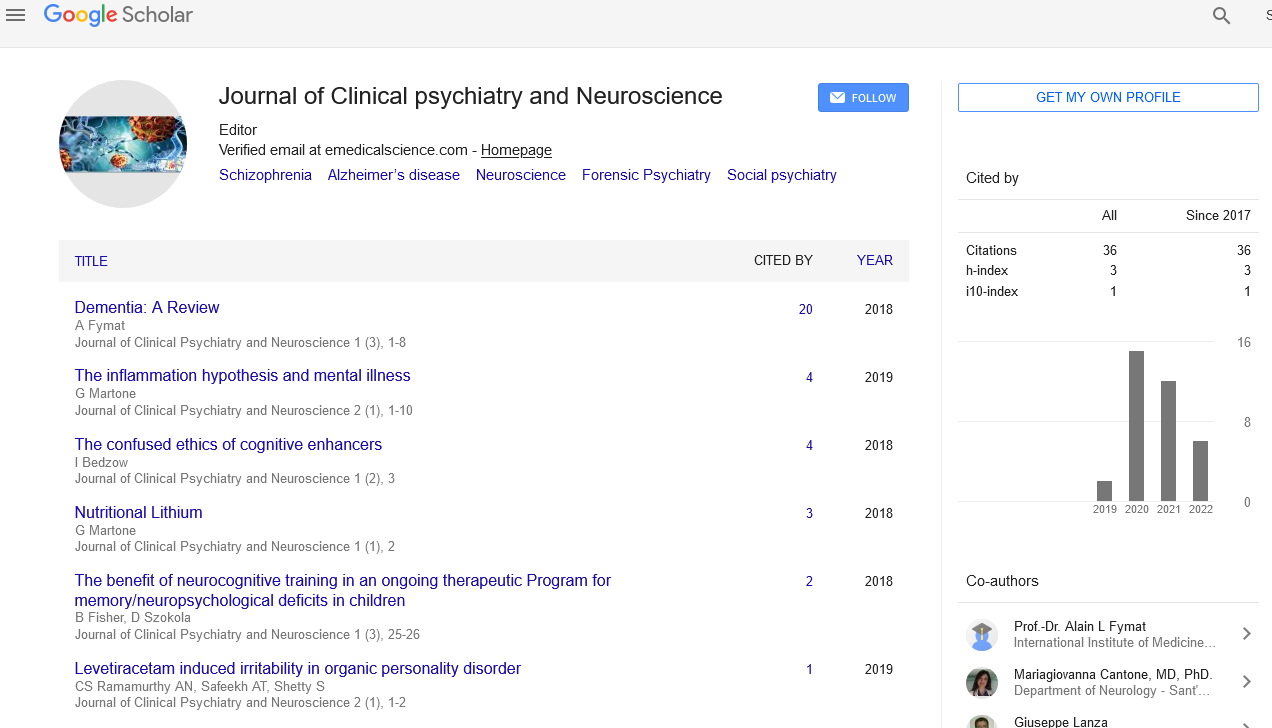Neuro-Use Oncology's of Mixed Reality: A Single Center Experience
Received: 06-Nov-2022, Manuscript No. PULJCPN-23-6130; Editor assigned: 08-Nov-2022, Pre QC No. PULJCPN-23-6130 (PQ); Accepted Date: Nov 24, 2022; Reviewed: 20-Nov-2022 QC No. PULJCPN-23-6130 (Q); Revised: 22-Nov-2022, Manuscript No. PULJCPN-23-6130 (R); Published: 27-Nov-2022, DOI: 10.37532/puljcpn.2022.5(6).68-9.
Citation: Bhanushali S. Neuro-use oncology's of mixed reality: A single center experience. J Clin Psychiatry Neurosci.2022; 5(6):68-9.
This open-access article is distributed under the terms of the Creative Commons Attribution Non-Commercial License (CC BY-NC) (http://creativecommons.org/licenses/by-nc/4.0/), which permits reuse, distribution and reproduction of the article, provided that the original work is properly cited and the reuse is restricted to noncommercial purposes. For commercial reuse, contact reprints@pulsus.com
Abstract
The majority of neurosurgery procedures now use intraoperative neuro navigation. Recent advancements in Mixed Reality (MR) technology have made an effort to address the drawbacks of neuro navigation systems. We discuss our experiences using the HoloLens 2 for intra- and extra-axial tumours in neuro-oncology. Outcomes We provide our observations with respect to three patients who had tumour resections. We assessed the surgeon's skills and the precision of the overlay 3D image in tumour localization using conventional neuro navigation both before and after surgery. HoloLens 2 training and use for surgeons was quick and simple. For the three situations, the picture overlay procedure was rather simple. With a traditional neuro navigation system, registration in the prone position can be challenging, but HoloLens made this problem much easier to solve. Verdict: The authors believe that this system is a workable alternative technology for intraoperative viewing of neurosurgical disease, despite several limitations that were noted. To evaluate its accuracy and applicability across multiple surgical fields, additional research is being planned.
Key Words
Mixed reality; HoloLens 2; Neuro navigation
Introduction
The development of Mixed Reality (MR) technology has created new opportunities for surgical planning, visualisation, and education. We have come a long way from the first Virtual Reality (VR) systems. The distinctions between virtual reality, augmented reality, and mixed reality have been very well explained. In contrast to AR, which combines virtual reality with the world as seen with the naked eye, and MR, which combines virtual reality with digital reality, VR is a pure virtual digital image. The distinction between MR and AR is that MR uses a camera to let you view reality that is hidden from view. Regardless of reality itself, augmented reality just superimposes the virtual surroundings. Although it has provided a new display technology, virtual reality has received criticism for a number of flaws. Then came Augmented Reality (AR), which offered some possibility for implementing brand-new visualisation techniques in neurosurgery for instruction and training. An precise and real-time video-based augmented reality display was made possible. DEXRay AR-based technology. The surgical workflow may easily incorporate the system.
Especially during the macroscopically phase of an operation, the seethrough effect displaying 3D information beneath the surgically exposed surface proved to be of substantial utility, offering clearly comprehendible structural navigational in- formation. Significant spatial comprehension knowledge is needed for neurosurgical procedures. Make sure the tumour is well confined because of its close proximity to vital vascular and neurological structures. Some of the tumours are very deeply embedded, thus proper localisation is necessary to avoid harming the healthy brain when treating the tumour. The majority of neurosurgery procedures now include intraoperative neuron avigation. Some of the frequent uses of intraoperative navigation include preoperative surgical planning, intraoperative localization of deep-seated tumours, stereotactic biopsies, and determining intraoperative resection margins for intrinsic tumours. The systems that are now on the market, however, have a number of drawbacks. First, the visuals projected on the screen are only in 2D, which the surgeon must convert to a mental 3D representation during planning. Though some systems include 3D reconstruction, it is rigidly based on the surgery's pre-op planning. These systems are limited to axial, sagittal, and coronal plane vision. No additional degrees of freedom exist, which frequently restricts the view of the target tumour, Second, any navigational errors that occur after preparation and draping necessitate re-registering and restarting the entire procedure. In an effort to address the drawbacks of neuron avigation devices, Mixed Reality (MR) technology has recently advanced, enabling the surgeon to superimpose a 3D-rendered image onto the anatomy of the patient. Its application has been restricted to instruction and sporadic intraoperative use. Recent investigations have indicated that it may be useful as a supplement to neuron avigation. The field of neurosurgery has been fortunate. Although interest in implementing new technology has been sluggish and pendulous, parallel breakthroughs in the Mixed Reality (MR) domains have allowed for a resurgence of interest in implementing new MR devices. MR has returned to the big screen thanks to HoloLens 2, which represents a considerable improvement over earlier VR and AR systems.
The norms of preoperative planning and registration in neurosurgery operating rooms have recently been challenged by recent developments in mixed reality systems. To determine the viability of employing HoloLens 2 in neurosurgery procedures without necessitating alterations to the current imaging proto cols, we presented a brief series of three patients. The authors have demonstrated that the user-friendly HoloLens 2 technology offers a different platform for intraoperative viewing of neurosurgical pathologies. The ability to see any image slice in any image enables the surgeon to comprehend how the pathology interacts with the nearby structures. Quantitative evaluation of the platform's accuracy using currently available gold standard neuron avigation systems still needs to be done.





